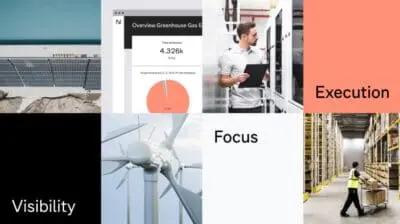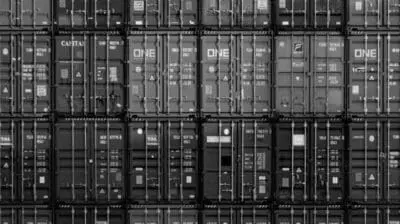How retailers can reduce carbon emissions

Retailers can drive impactful carbon reductions by engaging their value chains.
The retail sector accounts for roughly 25% of global emissions, with much of these emissions occurring in the retail value chain.
Reducing the carbon footprint of retailers and their value chains will play a vital role in reaching global climate targets – while for the retailers themselves, the benefits of carbon management extend beyond sustainability.
Retailers that effectively manage their carbon will stay compliant with existing and future legislation, minimize waste, and increase efficiency.
At Normative, we help retailers across many regions and sectors to manage their emissions. While every business will have a unique carbon reduction journey, there are trends and commonalities that apply throughout the retail industry. Here are some common challenges, effective solutions, and useful tools for retailers.
Common carbon management challenges in retail
For retailers, the value chain accounts for up to 98% of total emissions. To make impactful reductions, retailers will have to decarbonize their value chains – and they need accurate and comprehensive emissions calculations to lay the foundation for this work.
However, many retailers face challenges in quantifying emissions from their complex, global value chains.
These emissions – which fall under the Greenhouse Gas Protocol’s scope 3 – result from upstream and downstream business activities such as procurement, transportation and distribution, and end-of-life processing.
Upstream and downstream emissions, explained
To comprehensively report and reduce emissions, businesses need to calculate their upstream and downstream emissions sources.
Read the article
When it comes to upstream emissions, many of the calculation challenges arise within procurement.
Because retailers offer diverse product portfolios, they have many types of suppliers, working with many materials, and operating in many regions. This can make it difficult for retailers to collect the data needed to calculate emissions.
Value chain emissions are challenging to calculate
In addition, the emissions data from these suppliers may be low-quality – if they track any data at all.
Since retailers are the final link in the value chain before the customer, the businesses that directly supply the final product that retailers sell (known as “tier 1 suppliers”) are often wholesalers and trading organizations. Because these suppliers do not produce goods themselves, it can be challenging for retailers to collect product-level data.
Likewise, when it comes to driving reductions, retailers often have only limited influence over the climate impact of products from their tier 1 suppliers.
To calculate their full downstream footprint, retailers need to account for emissions that happen after the sale of their products, like product use and end-of-life treatment.
To comprehensively cover emissions in these categories requires data on product lifetimes, expected uses of the products, and the electricity required to use the products, amongst other activities.
This activity data is time-consuming to source, and often requires end-consumer insights that are difficult to obtain.
Carbon management challenges for retailers, in brief:
- Diverse product portfolios resulting in complex, global networks of suppliers.
- Limited ability to influence the sustainability of their product lines.
- Difficulty obtaining insights on product use and end-of-life treatment.
The consequences of incomplete carbon calculations
When retailers work from incomplete calculations, their carbon reporting and reduction initiatives will also be incomplete. This leaves businesses exposed to the risk of non-compliance with reporting legislation, and wastes time and resources that could have been more impactfully invested.
Poor data leads to ineffective action
Additionally, retailers with incomplete emissions data will not be able to provide credible proof of their sustainability work – leaving them vulnerable to allegations of greenwashing and preventing them from building brand equity and attracting customers.
Success story: Flying Tiger Copenhagen
The global retailer used carbon accounting to understand the carbon footprint of its complex supply chain and set SBTi-approved targets.
Read the customer story
Effective carbon reduction initiatives for retailers
To provide the foundation for effective carbon management, retailers should use science-backed carbon accounting to calculate their full emissions.
After calculating their value chain carbon footprints, retailers can drive impactful decarbonization by swapping high-emission products with more sustainable alternatives.
For example, a clothing retailer can reduce emissions by replacing virgin cotton products with alternatives that use a higher percentage of recycled fabric.
Likewise, by identifying high-emitting suppliers, retailers can engage those suppliers in emissions reduction initiatives. The three main approaches to supplier engagement are summarized in the table below:
Three approaches to supplier engagement
| Approach | Summary | Level of Complexity |
|---|---|---|
| Informative approach | Sharing best practices and materials on how to address emission reduction | Medium to low complexity. Medium involvement for the company. Suitable for all companies. |
| Passive enforcing approach | Updating internal procurement guidelines to prioritize suppliers that comply with sustainability criteria | High complexity. High level of involvement for the company. Suitable for larger, high-revenue companies. |
| Active enforcing approach | Updating supplier Code of Conduct to make it mandatory for suppliers to disclose their emissions. Obligatory reduction targets. | High complexity. High level of involvement for the company. Suitable for larger, high-revenue companies. |
To reduce downstream emissions, retailers can influence their customers to make more environmentally-conscious choices. This can be accomplished by, for example, clearly labeling products with recycling instructions.
There is one prerequisite to all effective carbon reduction initiatives: trustworthy emissions calculations.
As the classic management adage says, you can’t manage what you can’t measure. When retailers accurately and comprehensively calculate their emissions, they empower themselves to make impactful, verifiable carbon reductions.
FAQs
After calculating their full carbon footprints – including their value chain emissions – retailers can drive impactful decarbonization by swapping high-emission products with more sustainable alternatives, by engaging suppliers in emissions reduction initiatives, and influencing their customers to make more environmentally-conscious choices.
The retail sector contributes to climate change through the greenhouse gas emissions it produces through the creation, selling, and end-of-life treatment of its wares.
The retail sector accounts for roughly 25% of global emissions, with much of these emissions occurring in the retail value chain.
Normative calculates carbon emissions for retailers
Our carbon accounting engine calculates supplier emissions using transaction data that businesses already have on hand – resulting in accurate, comprehensive, and science-backed emissions estimates.












